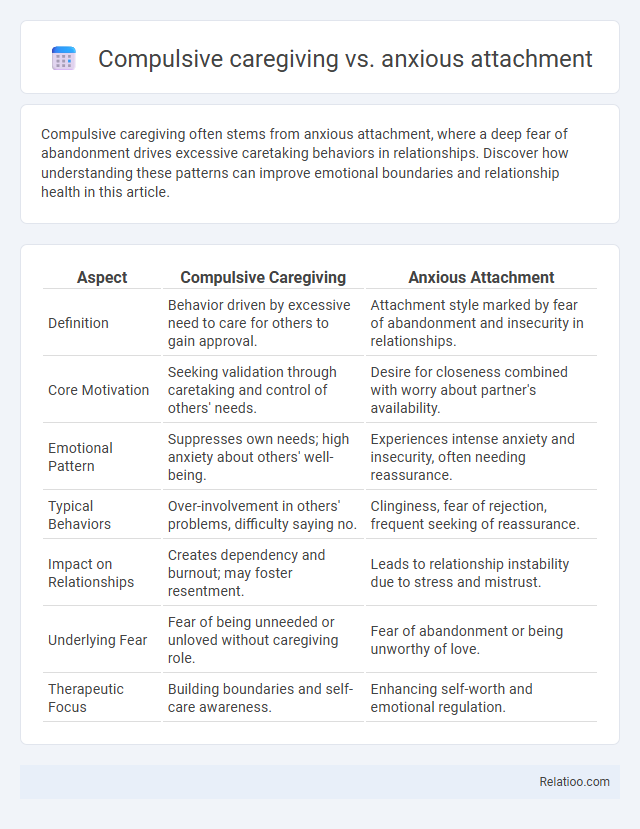Compulsive caregiving often stems from anxious attachment, where a deep fear of abandonment drives excessive caretaking behaviors in relationships. Discover how understanding these patterns can improve emotional boundaries and relationship health in this article.
Table of Comparison
| Aspect | Compulsive Caregiving | Anxious Attachment |
|---|---|---|
| Definition | Behavior driven by excessive need to care for others to gain approval. | Attachment style marked by fear of abandonment and insecurity in relationships. |
| Core Motivation | Seeking validation through caretaking and control of others' needs. | Desire for closeness combined with worry about partner's availability. |
| Emotional Pattern | Suppresses own needs; high anxiety about others' well-being. | Experiences intense anxiety and insecurity, often needing reassurance. |
| Typical Behaviors | Over-involvement in others' problems, difficulty saying no. | Clinginess, fear of rejection, frequent seeking of reassurance. |
| Impact on Relationships | Creates dependency and burnout; may foster resentment. | Leads to relationship instability due to stress and mistrust. |
| Underlying Fear | Fear of being unneeded or unloved without caregiving role. | Fear of abandonment or being unworthy of love. |
| Therapeutic Focus | Building boundaries and self-care awareness. | Enhancing self-worth and emotional regulation. |
Understanding Compulsive Caregiving
Compulsive caregiving involves an overwhelming need to care for others, often sacrificing Your own well-being in the process. Unlike anxious attachment, which centers on fear of abandonment and emotional insecurity, compulsive caregiving is characterized by a relentless drive to provide support, regardless of personal cost. Recognizing the distinctions between these behaviors can help you identify patterns and develop healthier boundaries.
What Is Anxious Attachment?
Anxious attachment is a psychological pattern characterized by intense fear of abandonment and a constant need for reassurance in relationships, often resulting from inconsistent caregiving during early childhood. Your caregiving style may lean towards compulsive caregiving when you overextend yourself to meet others' needs, driven by a deep-seated fear associated with anxious attachment. Understanding these patterns helps in addressing emotional dependence and establishing healthier, more balanced connections.
Key Differences Between Compulsive Caregiving and Anxious Attachment
Compulsive caregiving involves an overpowering need to help others, often neglecting personal boundaries and self-care, driven by a desire for control or approval. Anxious attachment centers on fear of abandonment and rejection, causing heightened sensitivity to relationship dynamics and dependence on others for emotional security. Your awareness of these key differences can improve relationship resilience by distinguishing between caregiving patterns motivated by control versus attachment insecurities.
Psychological Roots of Compulsive Caregiving
Compulsive caregiving often stems from unresolved childhood trauma and unmet emotional needs, leading individuals to seek validation and control through caregiving behaviors. This compulsion is distinct from anxious attachment, which involves fear of abandonment and a desire for closeness but may not manifest in excessive caregiving actions. Psychological roots of compulsive caregiving include underlying anxiety, codependency, and a need to suppress personal vulnerability by overextending care toward others.
How Anxious Attachment Develops
Anxious attachment develops primarily during early childhood through inconsistent or unpredictable caregiving, leading individuals to crave closeness yet fear abandonment. This attachment style is characterized by heightened sensitivity to relational cues and emotional dependency, increasing the tendency toward compulsive caregiving as a way to secure validation and reduce anxiety. Neurobiological factors involving dysregulated stress responses also contribute to the development and persistence of anxious attachment patterns.
Behavioral Signs of Compulsive Caregiving
Behavioral signs of compulsive caregiving include an excessive need to help others at the expense of one's own well-being, difficulty setting personal boundaries, and persistent feelings of guilt when not assisting. In contrast, anxious attachment often manifests as insecurity and fear of abandonment, leading to clingy or overly dependent behaviors rather than compulsive caregiving. Individuals with compulsive caregiving prioritize others' needs compulsively, often neglecting self-care, which can lead to emotional exhaustion and burnout.
Common Behaviors in Anxious Attachment
Common behaviors in anxious attachment include a persistent need for reassurance, heightened sensitivity to relationship cues, and fear of abandonment, which often lead you to experience emotional dependency and clinginess. Unlike compulsive caregiving, which emphasizes an excessive urge to care for others to the detriment of oneself, anxious attachment behaviors center on seeking approval and validation. Understanding these distinctions helps in recognizing how attachment anxiety influences relationship dynamics and emotional responses.
Impact on Relationships
Compulsive caregiving often leads to dependency issues where individuals sacrifice their own needs, creating imbalanced relationships and emotional burnout. Anxious attachment manifests as constant worry about rejection and need for reassurance, causing clinginess and emotional volatility that strains intimacy. The interplay of compulsive caregiving with anxious attachment exacerbates relational challenges by reinforcing codependency and hindered boundary setting, ultimately undermining healthy emotional connections.
Healing and Overcoming Attachment Patterns
Healing from compulsive caregiving and anxious attachment involves recognizing underlying emotional needs and setting healthy boundaries to reclaim your sense of self. Therapeutic approaches such as cognitive-behavioral therapy (CBT) and attachment-based therapy help reframe negative thought patterns while promoting secure relational connections. Developing self-awareness and self-compassion are crucial steps in overcoming these attachment patterns and fostering emotional resilience.
Strategies for Healthy Emotional Boundaries
Establishing healthy emotional boundaries involves recognizing patterns in compulsive caregiving and anxious attachment, such as people-pleasing or fear of abandonment. Strategies include assertiveness training, self-care routines, and mindfulness practices to maintain autonomy and emotional balance. Therapy approaches like cognitive-behavioral therapy (CBT) and attachment-based therapy provide tools for setting limits and fostering secure relational dynamics.

Infographic: Compulsive caregiving vs Anxious attachment
 relatioo.com
relatioo.com